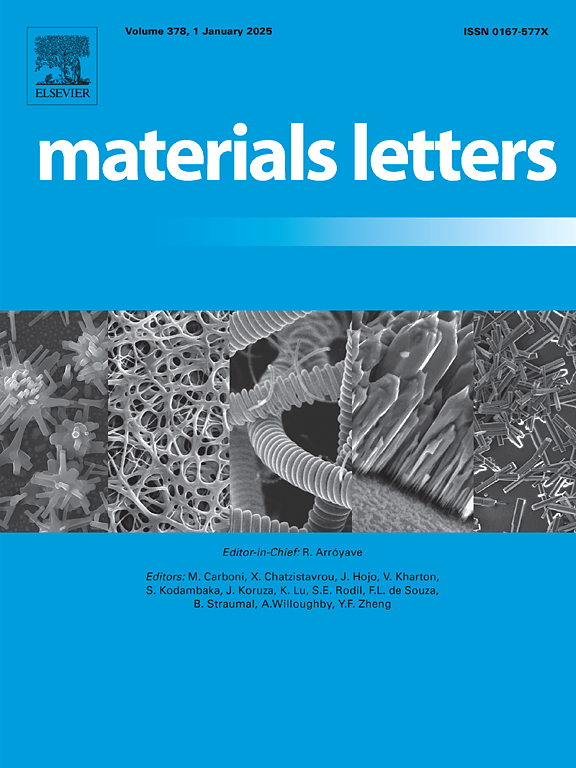正交Eu2CoMnO6双钙钛矿的结构、磁性和介电性能
IF 2.7
4区 材料科学
Q3 MATERIALS SCIENCE, MULTIDISCIPLINARY
引用次数: 0
摘要
采用固态法合成了Eu₂CoMnO₆(ECMO)多晶,并在高纯度的正交相pnm中结晶。场发射扫描电镜(FESEM)分析显示均匀的微米级颗粒,而拉曼光谱证实了(Co/Mn)O货号八面体振动特征,表明晶格有序。磁测量结果表明,在Tc≈89 K处铁磁跃迁,居里-魏斯拟合得到有效磁(μeff)≈15.1 μB/f.u。居里-魏斯温度(θCW)≈32 K,与主要的Co2+-O2−-Mn4+超交换、残余的反铁磁(AFM)相互作用和导致局部磁无序的Griffiths-like团簇一致。在10 K时,M-H环表现为软铁磁性,饱和磁化强度(Ms)≈117.93 emu/g,剩余磁化强度(Mr)≈23.148 emu/g,矫顽力场(Hc)≈0.67 t。介电研究显示了低频界面色散和稳定的高频体响应。ECMO的多功能性行为源于内在共序和外在微观结构效应的相互作用。本文章由计算机程序翻译,如有差异,请以英文原文为准。
Structural, magnetic, and dielectric properties of orthorhombic Eu2CoMnO6 double perovskite
Polycrystalline Eu₂CoMnO₆ (ECMO) was synthesized via the solid-state route and crystallizes in a high-purity orthorhombic Pbnm phase. Field Emission Scanning Electron Microscope (FESEM) analysis reveals uniform micrometer-sized grains, while Raman spectroscopy confirms characteristic (Co/Mn)O₆ octahedral vibrations, indicating a well-ordered lattice. Magnetic measurements show a ferromagnetic transition at Tc ≈ 89 K, with Curie-Weiss fitting yielding effective magnetic (μeff) ≈ 15.1 μB/f.u. and Curie-Weiss temperature (θCW) ≈ 32 K, consistent with dominant Co2+-O2−-Mn4+ superexchange, residual antiferromagnetic (AFM) interactions, and Griffiths-like clusters contributing to local magnetic disorder. M-H loops at 10 K indicate soft ferromagnetism with saturation magnetization (Ms) ≈ 117.93 emu/g, remanent magnetization (Mr) ≈ 23.148 emu/g, and coercive field (Hc) ≈ 0.67 T. Dielectric studies reveal low-frequency interfacial dispersion and a stable high-frequency bulk response. The multifunctional behavior of ECMO arises from the interplay of intrinsic Co![]() Mn ordering and extrinsic microstructural effects.
Mn ordering and extrinsic microstructural effects.
求助全文
通过发布文献求助,成功后即可免费获取论文全文。
去求助
来源期刊

Materials Letters
工程技术-材料科学:综合
CiteScore
5.60
自引率
3.30%
发文量
1948
审稿时长
50 days
期刊介绍:
Materials Letters has an open access mirror journal Materials Letters: X, sharing the same aims and scope, editorial team, submission system and rigorous peer review.
Materials Letters is dedicated to publishing novel, cutting edge reports of broad interest to the materials community. The journal provides a forum for materials scientists and engineers, physicists, and chemists to rapidly communicate on the most important topics in the field of materials.
Contributions include, but are not limited to, a variety of topics such as:
• Materials - Metals and alloys, amorphous solids, ceramics, composites, polymers, semiconductors
• Applications - Structural, opto-electronic, magnetic, medical, MEMS, sensors, smart
• Characterization - Analytical, microscopy, scanning probes, nanoscopic, optical, electrical, magnetic, acoustic, spectroscopic, diffraction
• Novel Materials - Micro and nanostructures (nanowires, nanotubes, nanoparticles), nanocomposites, thin films, superlattices, quantum dots.
• Processing - Crystal growth, thin film processing, sol-gel processing, mechanical processing, assembly, nanocrystalline processing.
• Properties - Mechanical, magnetic, optical, electrical, ferroelectric, thermal, interfacial, transport, thermodynamic
• Synthesis - Quenching, solid state, solidification, solution synthesis, vapor deposition, high pressure, explosive
 求助内容:
求助内容: 应助结果提醒方式:
应助结果提醒方式:


